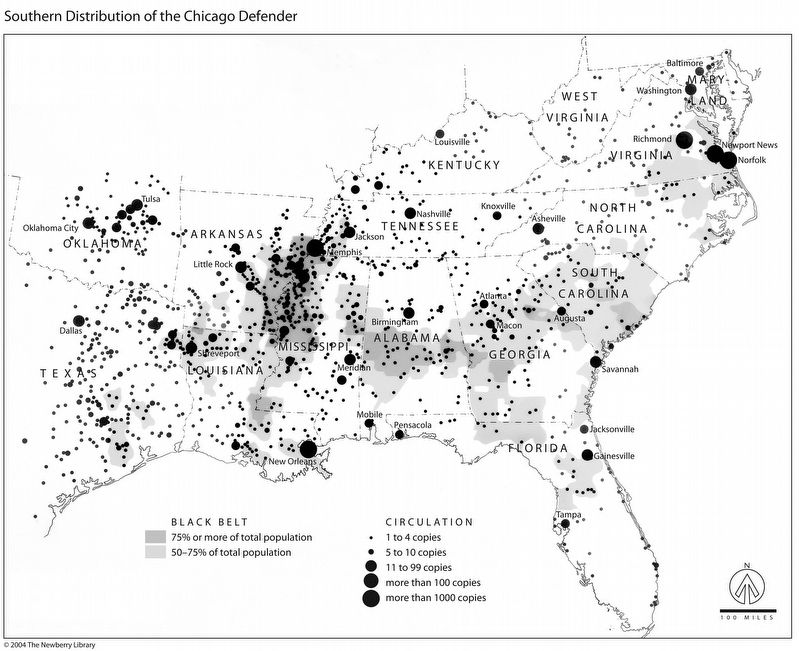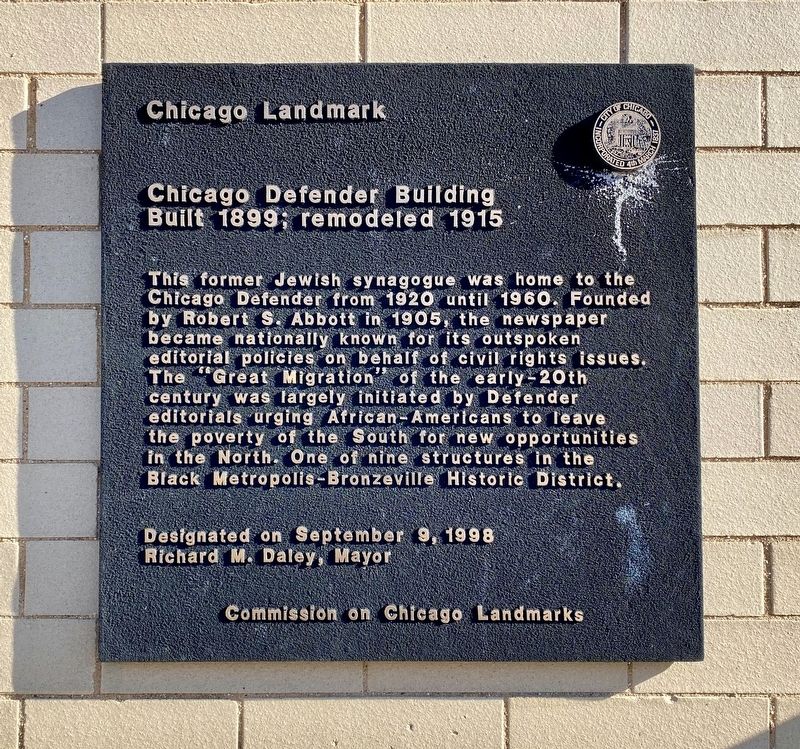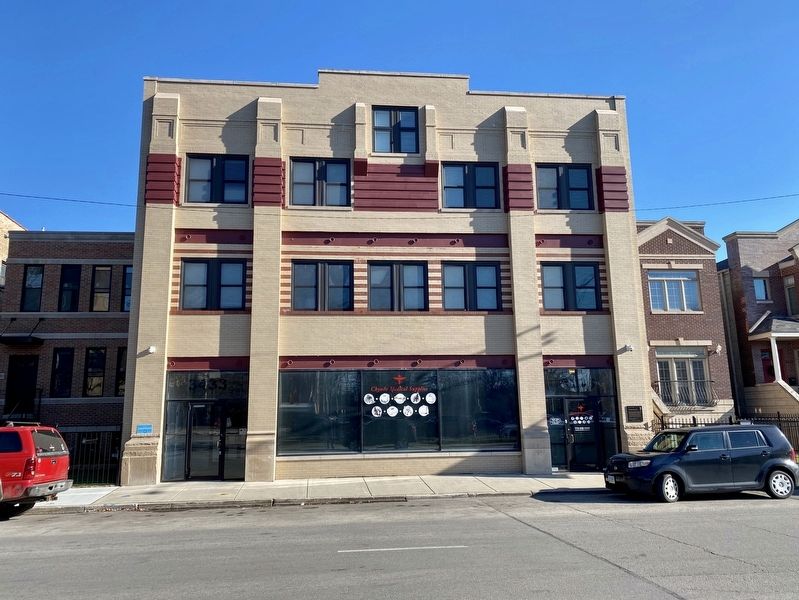Douglas (Bronzeville) in Chicago in Cook County, Illinois — The American Midwest (Great Lakes)
Chicago Defender Building
— Chicago Landmark —
Chicago Defender Building
Built 1899; remodeled 1915
This former Jewish synagogue was home to the Chicago Defender from 1920 until 1960. Founded by Robert S. Abbott in 1905, the newspaper became nationally known for its outspoken editorial policies on behalf of civil rights issues. The "Great Migration" of the early-20th century was largely initiated by Defender editorials urging African-Americans to leave the poverty of the South for new opportunities in the North. One of nine structures in the Black Metropolis-Bronzeville Historic District.
Designated on September 9, 1998
Richard M. Daley, Mayor
Erected by Commission on Chicago Landmarks.
Topics and series. This historical marker is listed in these topic lists: African Americans • Civil Rights • Communications. In addition, it is included in the Illinois, Chicago Landmarks Commission series list. A significant historical date for this entry is September 9, 1998.
Location. 41° 49.907′ N, 87° 37.298′ W. Marker is in Chicago, Illinois, in Cook County. It is in Douglas (Bronzeville). Marker is on South Indiana Avenue, on the right when traveling north. Touch for map. Marker is at or near this postal address: 3435 South Indiana Avenue, Chicago IL 60616, United States of America. Touch for directions.
Other nearby markers. At least 8 other markers are within walking distance of this marker. Sunset Cafe (approx. 0.2 miles away); Pilgrim Baptist Church (approx. 0.2 miles away); The Boulevard System (approx. ¼ mile away); State Street (approx. ¼ mile away); Victory, World War I Black Soldiers’ Memorial (approx. ¼ mile away); Welcome to Bronzeville (approx. ¼ mile away); Supreme Life Building (approx. ¼ mile away); Ida B. Wells-Barnett (approx. 0.3 miles away). Touch for a list and map of all markers in Chicago.
Also see . . .
1. Chicago Defender (1905- ) (Blackpast.org).
"The Chicago Defender was founded in 1905 by Robert Sengstacke Abbott. Abbott published the first issue, a run of 300 copies, on May 6, 1905....Abbott used the Defender as a forum to attack racial injustice from the outset, and included a front-page heading on every issue that read, “American Race Justice Must Be Destroyed”. The Defender was a leading advocate in the fight against racial, economic, and social discrimination. It championed equal employment and fair housing for blacks, and boldly reported on lynchings, rapes, and black disfranchisement. What began as a four-page handbill had become by 1915 a popular local newspaper with a weekly circulation of 16,000."(Submitted on December 15, 2021.)
2. The Chicago Defender (Wikipedia).
"The Chicago Defender is a Chicago-based online African-American newspaper. It was founded in 1905 by Robert S. Abbott and was once considered the "most important" newspaper of its kind. Abbott's newspaper reported and campaigned against Jim Crow-era violence and urged black people in the American South to come north in what became the Great Migration. Abbott worked out an informal distribution system with Pullman porters who surreptitiously (and sometimes against southern state laws and mores) took his paper by rail far beyond Chicago, especially to African American readers in the Southern United States. Under his nephew and chosen successor, John H. Sengstacke, the paper took on segregation, especially in the U.S. military, during World War II. Copies of the paper were passed along in communities, and it is estimated that at its most successful, each copy made its way into the hands of four out of five African-Americans."(Submitted on December 15, 2021.)

James R. Grossman, Newberry Library (courtesy of the Chicago Historical Society), 2004
3. Southern Distribution of the Chicago Defender, 1919
'This list, which ran to 64 galley-sized pages, was obtained by Military Intelligence ""in strict confidence"" from the Defender's distributor during the post-World War I federal investigations of radicals. The Defender's circulation of approximately 50,000 in 1916 was an important factor in the ""Great Migration"" of black Southerners to northern cities....By 1919 the Defender's advocacy of migration had won new subscribers, especially in the South, which contributed three-fourths of its approximately 130,000 circulation that year.'
Credits. This page was last revised on January 30, 2023. It was originally submitted on December 15, 2021, by Andrew Ruppenstein of Lamorinda, California. This page has been viewed 584 times since then and 125 times this year. Photos: 1, 2, 3. submitted on December 15, 2021, by Andrew Ruppenstein of Lamorinda, California.

